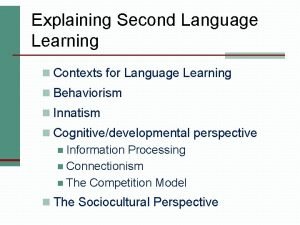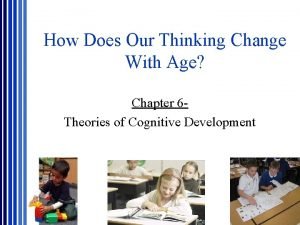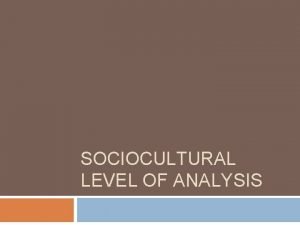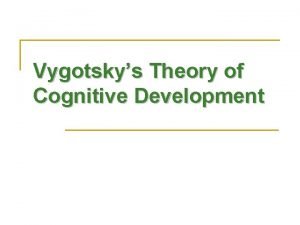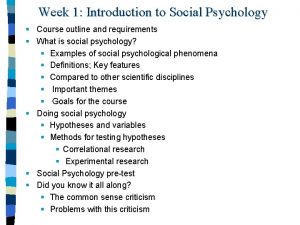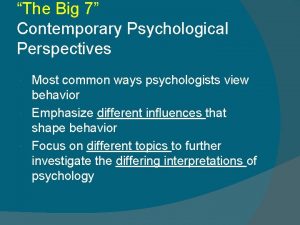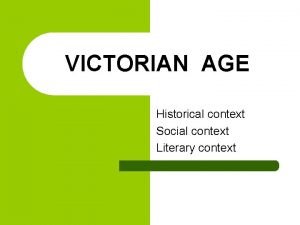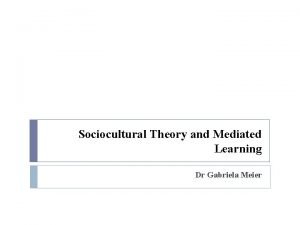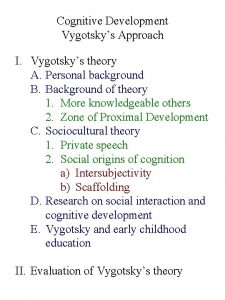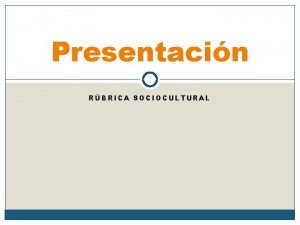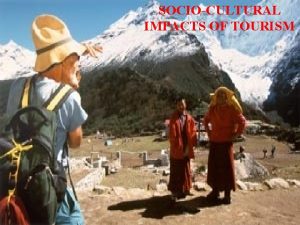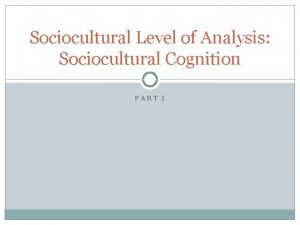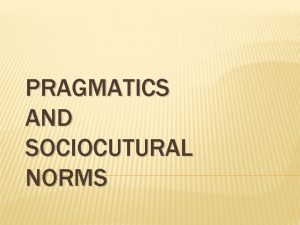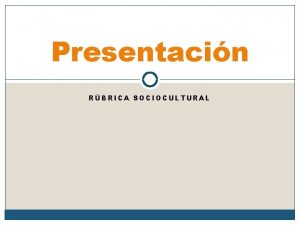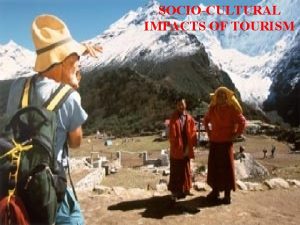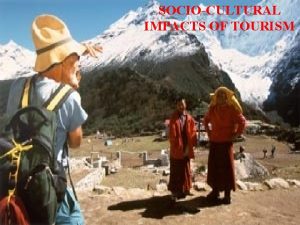Sociocultural influences 2 1 a Engagement patterns of











































- Slides: 43

Socio-cultural influences

2. 1. a. Engagement patterns of different social groups in physical activities and sports BY THE END OF THIS TOPIC YOU SHOULD … LEARNING OUTCOMES Be familiar with current trends in participation in physical activity and sport: Ø Using different sources (such as Sport England, NGB’s and Department of Culture Media and Sport) Ø Of different social groups Ø In different physical activities and sports.

Current trends in participation Priority/target groups are groups of people who have been identified as either not, or in danger of not, participating in sport or physical activity as much as they should. ‘Creating sporting habits for life’ Sport England Priority/Target Group (14 -16 year olds) 30 minutes sustained exercise per week. Sport England Priority/Target Group (16 -25 year olds) Since 2005/06 the number of 16 -25 year olds participating in sport has increased (3. 64 million to 3. 83 million). 55. 5% of 16 -25 year olds participate in sport once a week for 30 minutes or more. Sport England Priority/Target Group (26 year olds plus) 32. 4% of adults 26 years or older participate in sport once a week for 30 minutes or more. 40. 1% of men and 30. 5% of women participate in moderate intensity level sport at least once a week. Source: Sport England – Active People Survey 10 2015/16

Current trends in participation Priority/target groups Other important data In 2013 42% of 5 -16 year olds main method of getting to school was walking. 34% were driven to school. 2% cycled. Source: Public Health England - child physical activity data factsheet 2014 In 2013 81. 6% of 5 -15 year olds reported that they had done some form of competitive sport in the last 12 months. 78% had taken part in a competitive sport in school, 38% outside of school. Source: Department for Education – Evidence on physical education in schools 2013

Current trends in participation Strategies to improve participation in sport Task: What does this graph tell you about sporting trends in the UK? What are three most popular sports in the UK? Has this changed at any point? Which sports have grown in popularity? Which Sports have seen the largest drop in participation? Why might this be? Source: Sport England – Active People Survey 2013

Current trends in participation Popular sports/activities Most popular adult activities in the UK in 2017 Walking 19. 2 million Keep fit/yoga (including aerobics and dance exercises) 13. 4 million Swimming 4. 5 million Cycling 6. 2 million Racket sports (tennis, badminton, and squash) 2. 2 million Source: Sport England – Active Lives Adult Survey 2017/18

Current trends in participation Socio-economic groups The rate of participation among people aged 16 and over is greater in those from higher socio-economic groups (more money) than those from lower socio-economic groups( less money). Proportion of adults who take part in at least one sport or physical activity Higher socio-economic groups Manual and unemployed socio-economic 71% 54% Source: Sport England – Active Lives Adult Survey 2017/18

Current trends in participation Participation by gender Participate in sport activities Participate in organised competition Men Women 65% 60% 40% 14% Source: Sport England – Active Lives Adult Survey 2017/18

Current trends in participation Participation by age • The proportion of adults taking part in at least one sport or physical activity decreases with age (except for walking) Proportion of adults who take part in at least one sport or physical activity (including walking) 16 -24 year olds 65 -74 years 84% 83% Proportion of adults who take part in at least one sport or physical activity (excluding walking) 16 -19 year olds 70+ years 55% 19% Source: Sport England – Active Lives Adult Survey 2015/16

Current trends in participation Gender Data, analysis and evaluation The table below shows the difference between female and male football clubs and registered players. 2012 Gender Plays football as a member of a sports club Takes part in organised competition Female 13. 4% 14. 7% Male 19. 5% 27. 9% Source: Women's football fact sheet October 2012

Current trends in participation Disability Proportion of adults with a long term limiting illness or disability that played sport once a week 2015/16 2017/18 60. 9% 61. 8% * * compared to 81. 6% without a disability. Source: Sport England – Active Lives Adult Survey 2015/16 and 2017/18

Current trends in participation Ethnicity Proportion of adults who play sports once a week 2017/2018 Black and other minority ethnic groups 57% White British groups 63% Among women, those from white backgrounds are more likely to take part in sport compared to those from Chinese, black and other ethnic backgrounds. Source: Sport England – Active Lives Adult Survey 2017/18

Current trends in participation In sport in general Activity levels are highest for people from mixed ethnicity - 71% White British background is at 63%. The lowest are for people from South Asian – 55%. In basketball and cricket, more than a third are from a non-white background. Badminton and football also have a higher than average proportion of players from a non-white background. Non-white players make up a comparatively small share of cyclists and golfers. Source: Sport England – Active Lives Adult Survey 2017/18

2. 1. a. Engagement patterns of different social groups in physical activities and sports BY THE END OF THIS TOPIC YOU SHOULD… • Understand how different factors can affect participation, including: LEARNING OUTCOMES • • • • Age Gender Ethnicity Religion Culture Family Education Time Work Commitments Cost Disposable income Disability Opportunity Access Discrimination Environment / climate, media coverage, role models • Understand Strategies which can be used to improve participation: • • • Promotion Provision access • Be able to apply examples from physical activity / sport to participation issues.

Factors affecting participation in physical activity and sport Age Percentage of participants taking part at least twice a month by age 16 -34 years old 35 -54 years old 81. 5% 78. 4% Source: Sport England – Active Lives Adult Survey 2017/18 TASK: In pairs discuss what conclusions can we draw from this?

Factors affecting participation in physical activity and sport Age Average life expectancy has risen, so more and more people could participate. There is an increase in the number of teams for older people (veterans teams). Sport is often perceived as a ‘young person’s activity’. Some older people lack confidence to participate. Some older people’s participation may be affected by medical conditions or illness. Some activities have age restrictions • minimum age for London Marathon is 18 years • minimum age is for Olympic snowboarding is 15 years • Some fitness gyms have a minimum age restriction. Some NGBs have regulations that restrict the age gap between players (2 years etc. ) • In rugby players Under 12 years of age cannot ‘play up’. Many NGBs have developed adaptations of their sport that are suitable for older people • Walking netball, walking basketball and walking football are examples.

Factors affecting participation in physical activity and sport Gender Let’s look at some statistics for females and male football players Gender Member of a registered team/club Gender Plays at least once a week Female 13. 4% Female 0. 6% Male 19. 5% Male 9. 8% Gender Receives coaching/tuition in football Female 13. 8% Male 11. 8% Source: Women's football fact sheet October 2012 TASK: What patterns do you notice in the data tables above?

Factors affecting participation in physical activity and sport Gender Barriers to women playing sport are… TASK: Make a list of barriers to women participating in sport How many of these did you get? Lack of time and childcare Lack of self confidence Personal safety Parental and adult influence Male dominated culture of sport Funding Body image Lack of media exposure Lack of role models Sexism

Factors affecting participation in physical activity and sport Gender Women’s opportunities at elite level are growing all the time. With an increase in the women's sport profile, sponsorship and financial gain is becoming more readily available. Many female sports have seen a rise in media coverage and ultimately popularity. Opportunities for female officials and management roles within teams have grown too and there a great deal more female presenters on TV. TASK: Which women’s sports have seen an increase in coverage?

Factors affecting participation in physical activity and sport Gender Applying examples from physical activity / sport to participation issues The tables below show a summary of girls and boys who play sport in or outside school 11 to 15 year olds 5 to 10 year olds Gender 2012 2013 2014 2015 Girls 76. 4% 80. 1% 77. 2% 78. 6% Girls 92. 5% 94. 9% 93. 1% 95. 5% Boys 85. 1% 87. 8% 84. 8% 88. 3% Boys 97. 2% 98. 5% 96. 7% 96. 0% Source: Taking part 2015/16 Annual Child Report TASK: What patterns do you notice in the data table above?

Factors affecting participation in physical activity and sport Ethnicity, culture and religion The number of both black and minority ethnic and white British adults playing sport is increasing. Taking up a sport or activity may be influenced by ethnic background e. g. cricket is very popular within Asian countries. TASK: Which country, culture and/or religion would you associate with the following sports? Hockey Cricket Kabaddi Basketball Volleyball Aussie rules football Hurling Curling TASK: Explain why you think there are less black tennis players/golfers than footballers?

Factors affecting participation in physical activity and sport Ethnicity, culture and religion Applying examples from physical activity / sport to participation issues The tables below show a summary of ethnicity participation over 3 years Black and ethnic minority groups White British groups 2015/16 2016/17 2017/18 71. 6% 70. 4% 71. 4% 78. 5% 78. 9% Source: Sport England – Active Lives Adult Survey 2017/18 TASK: What patterns do you notice in the data table above?

Factors affecting participation in physical activity and sport Family You are more likely to participate in sport if your parents do. You are less likely to participate if there is little interest shown by your family. Family support is crucial: • Transport • Equipment/kit costs • Membership/match fees • Teaching sporting etiquette/sportsmanship Andy Farrell Owen Farrell Harry Redknapp Negative influences might include: Jamie Redknapp Frank Lampard snr • Poor sportsmanship/deviance Frank Lampard jnr • Unrealistic expectations All one family! • Placing undue pressures on children • Keeping children away from peers to gain higher levels of competitions. Tracey Neville Gary Neville Phil Neville TASKS Are there any ‘sporting families’ at your school? Explain how your family may have affected your involvement in your chosen sport…

Factors affecting participation in physical activity and sport Friends/Peers Friends and peers can greatly influence you. They can influence whether you participate or reject physical activity, instead persuading you to go to the cinema, smoke, drink, alcohol, take drugs, etc. They can influence what sport or physical activity you take up, asking you to attend a pilates class with them. They can influence whether you continue participating in later life, giving you a lift to a swimming pool or booking a health spa weekend for you both. Falling out with a friend or the peer group can make you change your interests in sport or stop altogether. Peer pressure makes you want to do what others do or don’t do. It is very powerful in relation to children’s attitudes. When you participate in sport or physical activity who do you participate with?

Factors affecting participation in physical activity and sport Disability Sport is encouraged to all regardless of disability. Performers with disabilities often compete against similar groups or can be mixed with able-bodied performers. More disabled people are taking part in sport – 17% in 2015 are playing sport regularly, up from around 15% in 2005/06. Participation rates have increased since 2012 London Paralympic Games, but overall those with a disability show a comparatively low percentage in participation. This may be due to the lack of adapted equipment, access, clubs, discrimination and/or a lack of confidence.

Factors affecting participation in physical activity and sport Disability Exam question (3 marks) Assess the trends in participation in sport from 2005/2006 until 2011/2012. Participants with disabilities Able bodied participants 2005/2006 15. 1% 37. 8% 2006/2007 16. 7% 39. 3% 2007/2008 16. 2% 39. 2% 2008/2009 16. 3% 38. 9% 2009/2010 17. 7% 37. 7% 2010/2011 18. 3% 39. 4% 2011/2012 18. 5% 39. 2%

Factors affecting participation in physical activity and sport Reasons for participation in sport and physical activity TASK: Identify 3 reasons for taking part in sport There are 5 reasons for participation in physical activity and sport: Can you create an acronym to remember these? 1. 2. 3. 4. 5. Media coverage Environment and climate Time Resources Role models Example: M - My E - Elephant T - Trains R - Racing R - Rabbits

Reasons people get involved in sport Media coverage TASK: Discuss the importance/influence of media on sport today and come up with an example of how media coverage affects participation rates in a certain sport Other possible reasons people do not get involved in sport (barriers to participation) • Media coverage – some sports get a great deal more media coverage than others which makes them more popular e. g. football vs hockey • Male sport still dominates although there is much more interest in women’s sport in recent years due to increased success e. g. GB women’s football reaching the quarter final of the 2012 Olympic Games • The media can stimulate participation in sports e. g. huge increase in tennis participation during Wimbledon as people watch it on TV and want to participate themselves • Our interest is especially increased when the media highlights the success of UK sports people e. g. lots of interest in cycling after the success in the 2012 Olympic Games when 6 world track records were achieved.

Reasons people get involved in sport Media coverage In the News In the year that Andy Murray won Wimbledon (2013) there was a FALL in the number of people who played tennis at least once a week. Sport England’s Active People Survey found that 406, 000 people played in the year 2013 – a fall of 39, 000 on the previous 12 month period. (PE second edition by J. Honeybourne) Tennis example – why did this happen?

Reasons people get involved in sport Media coverage Extension task: to be prepared for the exam it’s helpful if you learn a summary of how the media can affect participation in sport. Create a list of both the positive and negative affects of the media on participation in sport. Positive affects of media on sport Negative affects of media on sport

Reasons people get involved in sport POSITIVE aspects of the Media promotes or encourages sport and exercise, and increases interest through sports coverage promotes healthy living can motivate through role models promotional campaigns or public service broadcasting or through advertising provide a wide variety of sports, including minority and novel sports will create funds and sponsorship that can be used to encourage activity gives information about healthy lifestyles and fitness, e. g. via the internet or new training methods.

Reasons people get involved in sport NEGATIVE aspects of the Media may encourage or reinforce unhealthy or inactive lifestyle may show negative role models too much passive watching and listening to media discourages activity, causing the 'couch potato' syndrome minority sports (those in which few people participate) are often under-represented women's sports are under-represented or misrepresented disability sport is under-represented or misrepresented older performers are often under-represented can make people feel inadequate by not having the ability or skill or the 'sporty' body image might show the dangers of participation or (high) risk of injury that might put people off participation.

Reasons people get involved in sport Environment and climate – this can dictate which sports/activities people take part in e. g. if you live in an area that receives regular snow and has hills, then you are more likely to ski than someone who doesn’t.

Reasons people get involved in sport Cost / disposable income Cost Some activities/equipment/kit are too costly for everyone to be able to participate. Examples You need access to horses for: • polo • show jumping • point to point. Kit can be expensive for: • ice hockey • golf • Archery. Memberships can be expensive for • private golf clubs.

Reasons people get involved in sport Discrimination may prevent certain people from participating in a sports activity, due to: Race/colour: • in some countries certain ethnic minorities are prevented from joining clubs. Gender: • golf clubs not allowing women to participate at certain times or not at all • leisure centres having female only fitness classes. Disability: • people with disabilities not being allowed to join certain clubs. Age: • clubs making an upper age limit for membership to prevent older people joining.

Reasons people get involved in sport TIME Work commitments can get in the way of finding enough time for sport. Travel time to and from work may reduce time available for participating. Family commitments may reduce the time available for parents to participate.

Reasons people get involved in sport Opportunity / Access You may not have appropriate sports clubs or facilities near you which may prevent you from participating. Some local authorities provide transport to help increase participation e. g. buses to leisure centres for elderly people.

Reasons people get involved in sport Role models Like parents, other significant others can influence whether you participate in sport. These may include: • High level performers you have seen or read about in the media • Players in an older team at your club • PE teachers • Sports coaches who visit your school to coach specific sports activities. The behaviour/actions of some role models might be negative, which can cause problems if their followers copy their negative behaviours when they participate. TASK: Make a list of sporting role models. Indicate if they are positive or negative. Explain the reasons for your choices.

Strategies to get people involved in sport Promotion, provision and access The three important factors that can deliver successful strategies for improving participation are: 1. Promotion or convincing people they should take up sport 2. Provision of facilities, equipment, coaching etc. 3. Access or giving people opportunity to participate by making it easier for them to engage in sport.

Strategies to get people involved in sport Information, opportunities, facilities and availability More information/education on the benefits of regular sports participation e. g. TV advertising to show benefits of regular exercise or e. g. This Girl Can/advertising local clubs on the radio or Change 4 Life. Regular opportunities for coaching/instructing to enable more frequent participation e. g. fitness instructors available across the working day and evening. More facilities available for regular participation e. g. ensuring that each community is served by a leisure centre. Facilities available for longer during the day to enable regular participation e. g. local swimming baths open early morning and close late evening.

Strategies to get people involved in sport Facilities, adaption and childcare More accessible facilities or more localised facilities or better transport arrangements to access facilities e. g. facilities have wheelchair ramps or a (free) local bus service is provided. Cheaper facilities for sport or concessions for more adults to be involved e. g. the local leisure centres give concessions for the elderly or give cut price admission for regular users. Introduction of adapted games e. g. walking football, walking basketball, touch rugby for adults. Activities/sessions for adults only or age-group sessions e. g. adult/40 plus/50 plus fitness classes. Provision for childcare e. g. gyms that provide childcare/nursery/playgroup/youth group so that parents can exercise.

Participation rates Extension task Name and describe 2 social groups that might engage in physical activity. Explain how role models and media coverage might affect girls and boys taking part in physical activity? Engagement patterns of different social groups How might the cost or amount of disposable income affect the type of activity an individual could choose to do? Why might disability affect participation rates in sport?

OCR Resources: the small print OCR’s resources are provided to support the delivery of OCR qualifications, but in no way constitute an endorsed teaching method that is required by the Board, and the decision to use them lies with the individual teacher. Whilst every effort is made to ensure the accuracy of the content, OCR cannot be held responsible for any errors or omissions within these resources. Our documents are updated over time. Whilst every effort is made to check all documents, there may be contradictions between published support and the specification, therefore please use the information on the latest specification at all times. Where changes are made to specifications these will be indicated within the document, there will be a new version number indicated, and a summary of the changes. If you do notice a discrepancy between the specification and a resource please contact us at: resources. feedback@ocr. org. uk. © OCR 2018 - This resource may be freely copied and distributed, as long as the OCR logo and this message remain intact and OCR is acknowledged as the originator of this work. OCR acknowledges the use of the following content: • 5 > Young family walking in park / Monkey Business Images / Shutterstock. com • 22 > Fun time with friends / g-stockstudio / Shutterstock. com • 6 > A large group of people hiking the Chiltern Hills during a bright summer day / mikecphoto / Shutterstock. com / ED • 23 > Disabled sport men in action while playing indoor basketball at a basketball court / marino bocelli / • 8 > Disabled mature woman on wheelchair playing tennis on tennis court / Nejron Photo / Shutterstock. com • 9 > Young arab muslim woman working out in a Gym Dubai UAE / Naufal MQ / Shutterstock. com • 16 > Boxer practicing her punches at a boxing studio / Jacob Lund / Shutterstock. com • 16 > Young female journalist interviews man focus on woman / Pavel L Photo and Video / Shutterstock. com • 16 > British athlete Jessica Ennis-Hill Madame Tussauds wax museum / Anton_Ivanov / Shutterstock. com / ED • 18 > Nuchanart Maiwan kabaddi player from Thailand participates in an Asian Indoor and Martial Arts Games / Pal 2 iyawit / Shutterstock. com / ED • 21 > Owen Farrell of Saracens / takaimages / Shutterstock. com / ED • 21 > Tottenham's manager Harry Redknapp / Mitch Gunn / Shutterstock. com / ED • 21 > Gary Neville assistant manager for the England national football team / katatonia 82 / Shutterstock. com / ED Shutterstock. com • 25 > Rabbit / anetapics / Shutterstock. com • 26 > British newspaper front pages reporting on England's World Cup / Lenscap Photography / Shutterstock. com / ED • 31 > Group of young children learning to practice skiing / Cristian Balate / Shutterstock. com • 31 > Two young ladies surfers running into the sea with surf boards / Dudarev Mikhail / Shutterstock. com • 33 > Drawing of football players / Povsydu / Shutterstock. com • 34 > Tired woman hiding face behind clock at table in office / Pixel-Shot / Shutterstock. com • 35 > Field closed sign blocking access to a field in a park outside / David Tran Photo / Shutterstock. com • 36 > Lance Armstrong on Champs Elysees in Paris 2004 / Marc Pagani Photography / Shutterstock. com / ED Please get in touch if you want to discuss the accessibility of resources we offer to support delivery of our qualifications: resources. feedback@ocr. org. uk
 Sociocultural graded influences
Sociocultural graded influences Obj dating
Obj dating Closed patterns and max-patterns
Closed patterns and max-patterns Escenario socio-cultural
Escenario socio-cultural Child directed speech definition
Child directed speech definition Contexto historico y literario del romanticismo
Contexto historico y literario del romanticismo Escenario sociocultural
Escenario sociocultural What is a socio-cultural context? explain briefly.
What is a socio-cultural context? explain briefly. Little emphasis on sociocultural context
Little emphasis on sociocultural context Sociocultural system
Sociocultural system Sociocultural level of analysis
Sociocultural level of analysis Without my partner in
Without my partner in Segmentacion sociocultural
Segmentacion sociocultural Aluso
Aluso Guided participation vygotsky
Guided participation vygotsky Contexto cultural del renacimiento
Contexto cultural del renacimiento La tragedia griega edipo rey pertenece al género
La tragedia griega edipo rey pertenece al género Contexto historico y social del realismo
Contexto historico y social del realismo Sociocultural perspective
Sociocultural perspective Segmentacion vals
Segmentacion vals Social psychology course outline
Social psychology course outline Sociocultural
Sociocultural Kanuk criteria
Kanuk criteria Pqrst pneumonic
Pqrst pneumonic Cultural materialism anthropology
Cultural materialism anthropology The observer effect
The observer effect Sociocultural segmentation example
Sociocultural segmentation example Sociocultural level of analysis
Sociocultural level of analysis Contexto sociocultural del renacimiento
Contexto sociocultural del renacimiento Paisaje sociocultural
Paisaje sociocultural Paradigma sociocultural
Paradigma sociocultural Deprivacion sociocultural
Deprivacion sociocultural Comprensión del entorno sociocultural
Comprensión del entorno sociocultural Ambiente del cuento el patito feo
Ambiente del cuento el patito feo Physical environment segment
Physical environment segment Abordagem sociocultural
Abordagem sociocultural Siglo xix contexto social
Siglo xix contexto social 7 psychological perspectives
7 psychological perspectives What is literary context
What is literary context Dr gabriela meier
Dr gabriela meier Barbara rogoff biography
Barbara rogoff biography Sociocultural knowledge
Sociocultural knowledge Vygotskys theories
Vygotskys theories Fuente epistemológica profesional
Fuente epistemológica profesional




